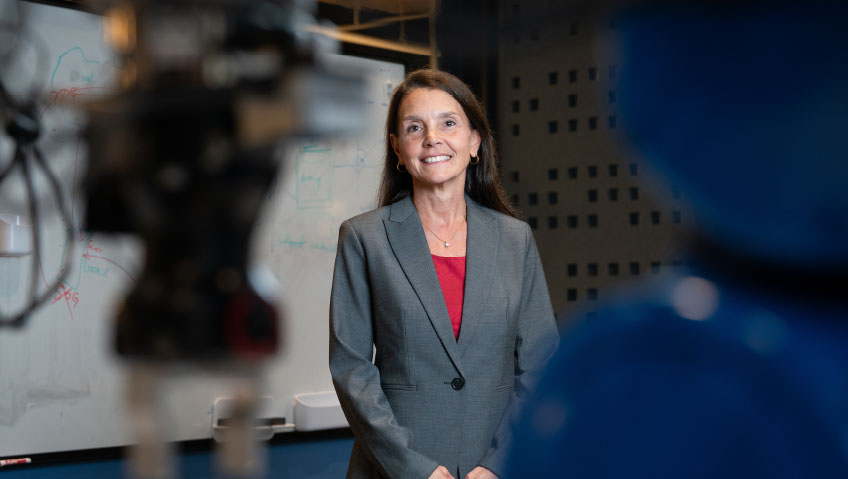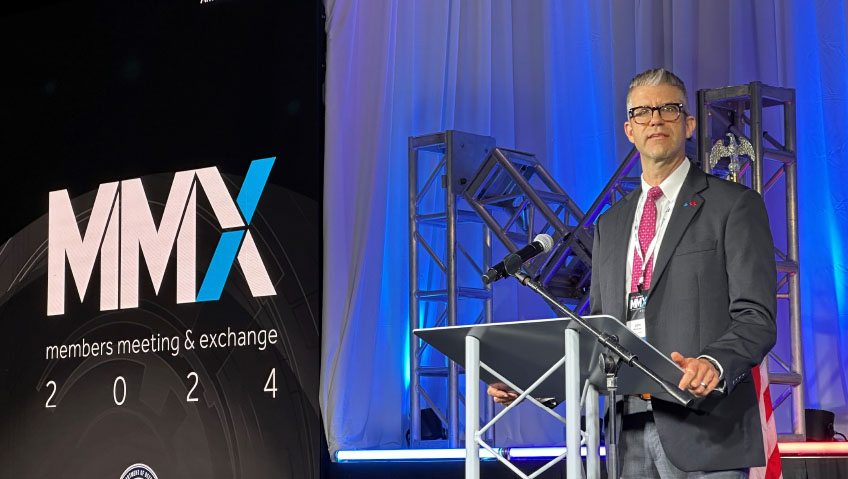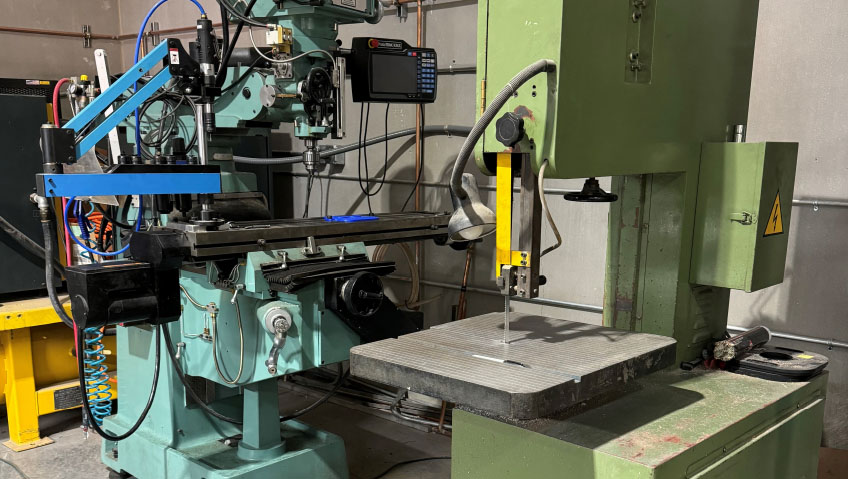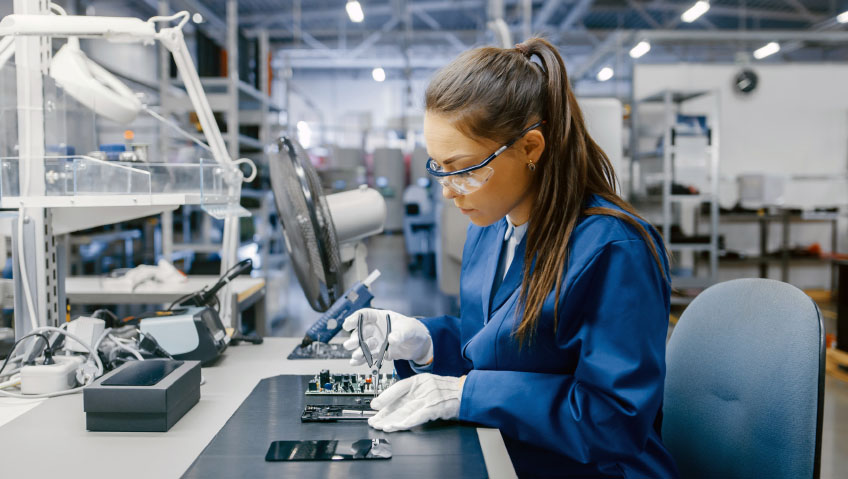One of the top research facilities in the world for metals additive manufacturing, the Next Manufacturing Center advances 3D printing technology by leveraging the combined engineering and data science expertise at Carnegie Mellon University.
Researchers there are creating new methods for design optimization, materials development and characterization, process parameter selection, and parts qualification and certification, that have helped to drive the widespread adoption of additive manufacturing (AM) technologies. Their work has helped to mature the technology by enabling faster, more efficient and reliable production of parts that can be lighter in weight, superior in mechanical properties, and more complex in geometry.
Sandra DeVincent Wolf is the Executive Director of both the Next Manufacturing Center and Carnegie Mellon’s Manufacturing Futures Institute, which brings engineers and scientists from across the university together to advance the digital transformation of manufacturing by applying digital technologies such as artificial intelligence; advanced data analytics; augmented, virtual, and mixed reality; and digital twins to a wide range of manufacturing technologies, including robotics, micro and nano manufacturing, biomanufacturing, and additive manufacturing.
Wolf oversees two AM labs—one on the Carnegie Mellon University campus and a second at Mill 19, where both faculty researchers and engineering students conduct additive manufacturing research in a facility that was built on the former site of one of Pittsburgh’s largest steel mills.
The AM equipment in the labs includes aerosol jet printing, binder jetting, bioprinting, directed energy deposition, electron beam melting, laser hotwire, laser powder bed fusion, and wire arc additive manufacturing. The facilities are available for use by both university faculty and students as well as industry partners.
Next Manufacturing’s research employs artificial intelligence and machine learning to advance part design; process development, monitoring, and control; materials development; qualification and certification of parts; and robotics and automation. These advances will significantly increase build rates, reduce costs, improve properties such as fatigue resistance, allow for customization of the entire process, and ultimately enhance the widespread adoption of AM.
“Thanks to our ability to apply the ever-increasing computer power and AI expertise we have at Carnegie Mellon, we can now gather and analyze vast amounts of data to optimize these complex processes,” explains Wolf, who adds, “It’s astonishing how the work in the lab has evolved. We now spend more time setting up cameras and microphones to collect visual and audio data than we do actually running a build. It’s very efficient. It’s phenomenal.”
“I started at CMU in 2015, and my primary responsibility was to introduce outside industry, federal entities, and other organizations to the research and capabilities that we have, and to meet with those organizations to understand their challenges and interests, and then work to bring those together to develop partnerships that would support our research,” says Wolf.
“At that time, the aviation industry was developing an interest in using metal additive manufacturing, leading to increased activity as companies began calling us to inquire about industry developments and whether it would be significant enough for them to consider serving the additive manufacturing industry, in addition to traditional powder metallurgy industries,” she explains.
“Manufacturing organizations were honestly worried that metal 3D printing might replace what they do, and that machining wouldn’t be needed anymore,” says Wolf. “Fortunately, they’re not being replaced at all. They’re needed more than ever, and their skill set is essential to the system, whether it’s making fixtures and jigs or finish-machining parts that are 3D printed.”
Recognizing the growing activity in this area, in 2015, the Dean of the College of Engineering approved mechanical engineering professor Jack Beuth’s request to establish an additive manufacturing center.
“That was all it was at that time—there was no agreement, no plan, no program,” Wolf recalls. “In January 2016, Beuth and materials science and engineering professor, Tony Rollett, and I committed to diving into this. I agreed to serve as the founding Executive Director of the Center, and we just started building and building.”
Wolf collaborated with the legal department and the office of sponsored programs to develop the membership agreement before presenting it to companies eager to learn about additive manufacturing and what Next Manufacturing was doing in the field.
“We launched the consortium in July 2016, marking our very first Next Manufacturing Center Membership Meeting and Research Expo, with attendees from all over coming to meet our faculty and students, interact with others in the industry, learn about our research, and tour our facilities,” says Wolf. “We hosted some elected officials and top representatives from the FAA and the aviation industry, which is where metals additive was really gaining traction. At that time, we had one small metals additive lab with a couple of machines, two faculty members, and four students using it all.”
Since then, the Center has worked tirelessly to promote its capabilities and efforts to support interdisciplinary research, resulting in 35 faculty and 175 students considering themselves affiliated with the Center. There are now two metals additive labs designed and built under Wolf’s leadership.
“I might have 30-some-odd students qualified to use the metals additive lab, which is a process, so that’s an accomplishment,” she notes. “Kudos to those students who have followed all of our training protocols and gotten qualified to work in the labs. That’s something that sets us apart from many universities.”
Metals additive manufacturing can be hazardous, she adds. Handling powders poses significant environmental health and safety risks, including potential inhalation. “It requires extensive infrastructure, and we have managed to operate safely despite these challenges. We also handle reactive powders like aluminum and titanium, which introduces a whole other level of risk since they can be combustible and even explosive.”
The Center’s equipment is available to all its researchers, with external rates for those in the industry who lack such capabilities. Additionally, professional staff are responsible for maintaining the labs’ equipment and ensuring safety.
“We’re very well known for our development of materials, new alloys, and process monitoring and control,” Wolf says. “I would also say we’re leaders in applying AI to additive manufacturing, which has been a primary focus of our research for the last four years. While we continue with process or alloy development, we are utilizing and applying AI as a tool to accelerate our efforts and do it more accurately. As humans, we alone can’t process all the data we can now collect with available computing power.”
In manufacturing—or science in general—when there’s a need for advanced data analytics and the ability to collect vast amounts of rich data, there’s really no other way to achieve this today, Wolf explains, but fortunately, the Center has the computing power to manage it.
“Now that we can monitor all these aspects, it’s astonishing how the work in the lab has evolved. You spend more time setting up the build in order to collect data than actually running a build because of the amount of information you can gather. The experiments are very efficient. It’s phenomenal how much valuable information you can collect in a short amount of time.”
On the funding side, the Center has been fortunate in securing various grants from different branches of the federal government, enabling it to advance vital research. According to Wolf, the Consortium, which was quite large in its earlier years, positioned the Center to win several federal grants including three with the Department of Energy for over two million dollars each for heat exchangers. There’s also been funding from the Office of Naval Research, for a Lockheed Martin-led project that included Center researchers, as well as a NASA University Leadership Initiative program totaling $6 million over three years and a NASA Space Technology Research Institute program funded at $15 million over five years, which has allowed the Center to pursue qualification of additive Laser Powder Bed Fusion (L-PBF), particularly for aviation. The Center is currently wrapping up an AI-enabled AM program funded at $15.7 million over four years supported by the Army Research Laboratory.
One of the Center’s greatest strengths, says Wolf, is that it “includes faculty with deep expertise in important topics like material development, solidification processing, modeling and simulation, design, and advanced data analytics and AI. It allows us to go both deep and broad at the same time to address AM challenges.”
Additionally, the Center’s commitment to fostering an “extremely collaborative environment” has proven invaluable.
“It shouldn’t be a secret sauce; everybody should be collaborating everywhere, and that’s one of the things that’s really special about the Center,” Wolf emphasizes. “My personal mission the entire time I’ve been at CMU is to bring people together, to find the right people, to help others.”
Part of Wolf’s success is her dedication to continuous learning and staying informed. “It’s never too late to learn,” she says, and after extensive experience across various industries, she feels that Carnegie Mellon is the perfect fit. “I’ve finally arrived. I am in a place that I absolutely love, because it’s incredibly exciting. The innovation is outstanding.”
The students are equally impressive, she adds, enthusiastic about being part of the Center. Seminars are highly attended, allowing students to broaden their knowledge beyond their own research.
“We also see students collaborating significantly. They love it; they love being part of this. Some students have even told us that this Center is the reason they chose us over other grad school options while pursuing additive manufacturing.”
The Center is committed to supporting these students, particularly in their research endeavors. “We train them. We want them to be hands-on and capable, which doesn’t happen at every university,” Wolf says. “We also foster a strong collaborative culture of safety in our labs, which is something we are very proud of.”
She is equally proud of the students’ generosity with their time, skills, and knowledge, as well as their willingness to share what they know with others, whether it’s safely training peers or operating various lab machines. “Every one of them is so grateful for their opportunities that they pay it forward or backward. They’re just so generous and gracious.”
Looking ahead, the Next Manufacturing Center aims to continue with automated and data-driven qualification and certification as a pathway to true adoption of additive manufacturing. The goal is also to attract more students and raise awareness of the vast possibilities within the manufacturing field.
“We have the advantage. 3D printing is the best thing that’s happened to metallurgy in years,” Wolf says. “We have an outreach tool, if you will. We have a technique—even if it’s just desktop plastic 3D printing—that’s so visual and so accessible. For $300 to $500, you can have a desktop 3D printer.”
This accessibility means schools, libraries, and community centers are now being introduced to the field, which can only benefit the broader industry.
“Even if you’re a non-technical parent or teacher, you can acquire one, and it’s for girls and boys,” Wolf says. “Additive is on the move now, and that’s incredibly exciting when trying to engage kids in STEM, particularly in additive manufacturing.”






